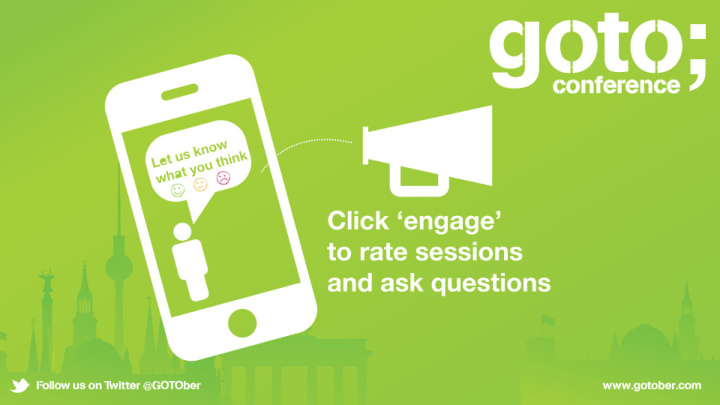



Mobile at scale GOTO Berlin - December 2015 Mattias Björnheden - Mobile chapter lead @amnbletochange
Spotify Founded 2006 75M+ Users 2+ Billion user playlists 58 Countries 1500+ employees
Spotify Mobile apps ‣ Majority of our users ‣ Offline capable ‣ 30+ developers on each platform ‣ 1000+ changes in each release
Building a small app
One team “The mobile team”
Linear development Build feature The team has capacity A for one or two features at a time. Release Release when ready. Build feature B Release Tweak feature A
Constant pressure Just need to get feature x out and all will be great...
Shifting priorities “We know x is almost done but right now we really need to work on Y”
What about quality?
We used to be here ‣ Unknown, varying quality ‣ Manual tests ‣ Unpredictable releases ‣ A lot of abandoned work in progress
Half a year of work
There are solutions ‣ Agile ‣ Clear prioritization ‣ Continuous integration ‣ Feature flags ‣ Focus on testing and test automation
We implemented some of these and also started thinking about....
Building a big app
Multiple teams How do we organize them?
Parallel development Prepare Teams have capacity Tweak Build Prototype for feature A feature B feature C feature D for multiple features. Synchronization. iOS Android Division of work release release Tweak Tweak Build Prototype feature A feature B feature C feature E
Dependencies With multiple teams and division of work they start to depend on and block each other
System design “Organizations which design systems are constrained to produce designs which are copies of the communication structures of these organizations” - Conway’s law
What about quality?
We have spent some time here ‣ Duplication of work ‣ Regression ‣ Teams blocking on each other ‣ Bloat ‣ Navigation items named after our teams
There are solutions
Building the Spotify app
What it is Feature rollout and Feature A/B test framework Feature Feature Feature Features e.g Playlist Hundreds of microservices Design components Dynamic view Shared core library frameworks for e.g. (C++) Browse
Built by autonomous feature teams Aligned through design, product and quality guidelines
Squad Squad Squad Squad iOS devs Android devs P P P P
Successes ‣ Solves a lot of synchronization ‣ Fast - teams seldom block on each other ‣ Feature parity across platforms ‣ Autonomy -> happy developers
Failures we have learned from ‣ Hard to execute on big projects ‣ Suboptimization ‣ Inconsistent design ‣ One squad -> one view -> one navigation item ‣ Rewrite surprise ‣ Duplication
Alignment
On priorities
On design
On quality
Through strict release rules For a year we spent about a third of our mobile capacity building continuous integration tools and infrastructure. We (aim to) ship every two weeks with strict quality rules. If a feature is not release ready it is disabled.
Rules are not top down We fail, we discuss, we decide on new rules to follow. It is not strong managers who come up with and enforce rules. It is strong squads and guilds who agree on best practices.
We accept some duplication ‣ We believe autonomy and simplicity is more important than trying to synchronize all efforts. ‣ We treat duplication similar to optimization. Fix it when we need to. ‣ It is often easier merge two or three working solutions into a great one than trying to build a generic one from the start.
In practice
Feature example Playlist filter and sorting Assume we did not have this feature, what would implementation look like from start to finish.
Mission “Help users find things in big playlists”
Squad planning meeting Where does filter logic go? ‣ UI layer, C++ layer, ○ The squad should backend What is the user ‣ have the people experience? and skills to own Input from product & ○ all these points. design How do we test? ‣ AB versions ○ Lead platform ○ Who will implement? ‣ Who do we depend on? ‣
Implementation ‣ Agile process - specifics decided by squad with help from agile coach. ‣ Sync through stand ups and daily collaboration. ‣ Designer and product owner heavily involved.
Development ‣ Start by creating flags for AB-testing and rollout. ‣ Build feature behind flags. ‣ Continuous integration.
Quality ‣ All code is reviewed ‣ Unit tests for all code, run pre-merge ‣ Automated tests run pre- and post merge. ‣ Manual QA in squad for all steps. ‣ Employee testing before rollout ‣ Gradual rollout (both clients and features) ‣ Feature and client metrics monitored constantly
Deployment ‣ Client release branches cut every 2 weeks. ‣ Release branches stabilizing 0-10 days. ‣ Incremental rollout starts as soon as there are no blockers on release branch. ‣ Nightly builds from master to employees.
TLDR
Recommend
More recommend